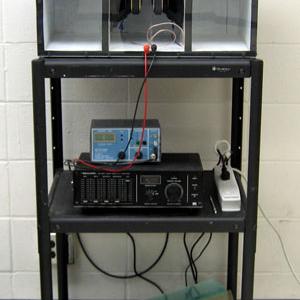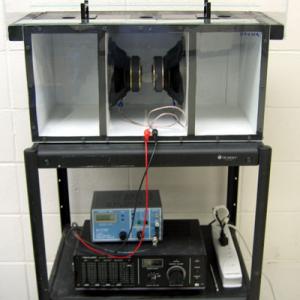College of Liberal Arts & Sciences
3D40.56 - Low Frequency Glass Breaker
Place a glass plate on the knife edge supports and center above the air holes on the top of the box. The knife edge supports should be positioned at .227 L from each end of the glass plate. The resonant frequency of the plate should be between 31 and 35 Hz. Once the resonant frequency is found, turn up the amplifier until the glass plate breaks in half.
NOTE: When using new glass plate, it sometimes helps to scratch the center of the glass plate with some sandpaper to get it to break. If all else fails, you can score the center of the plate with a glass cutter. This will insure that the glass breaks before you damage your speakers by overdriving them.
To make the maximum resonant frequency more visible, you can aim a laser at the middle of the glass plate. The reflection of the laser beam on the wall will look like a line that lengthens as resonance is reached.
Disclaimer: These demonstrations are provided only for illustrative use by persons affiliated with The University of Iowa and only under the direction of a trained instructor or physicist. The University of Iowa is not responsible for demonstrations performed by those using their own equipment or who choose to use this reference material for their own purpose. The demonstrations included here are within the public domain and can be found in materials contained in libraries, bookstores, and through electronic sources. Performing all or any portion of any of these demonstrations, with or without revisions not depicted here entails inherent risks. These risks include, without limitation, bodily injury (and possibly death), including risks to health that may be temporary or permanent and that may exacerbate a pre-existing medical condition; and property loss or damage. Anyone performing any part of these demonstrations, even with revisions, knowingly and voluntarily assumes all risks associated with them.



